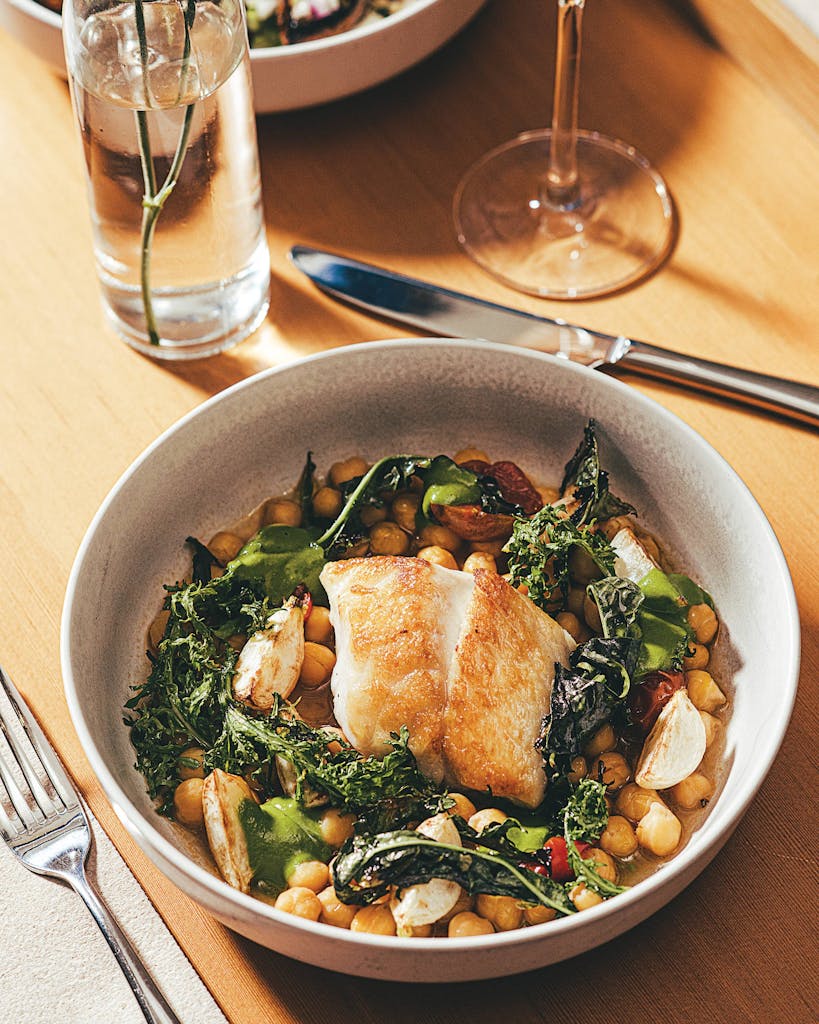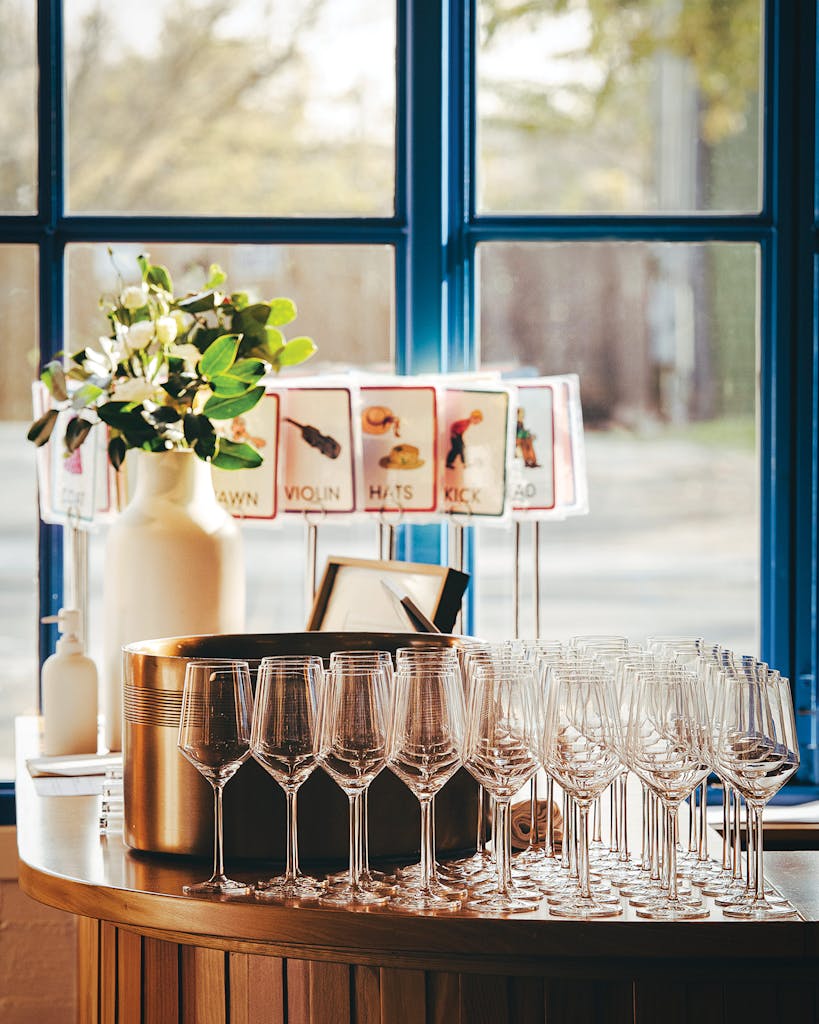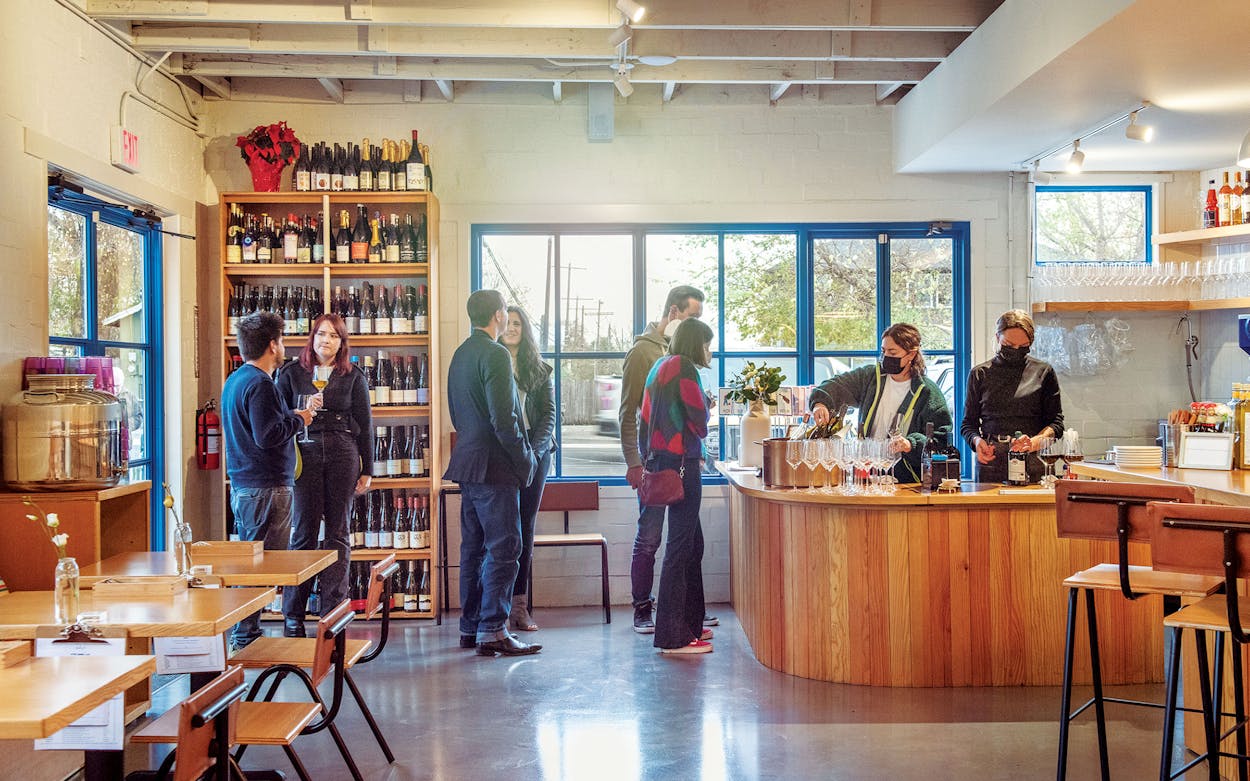Over the course of my life, I have stood in line to order cheeseburgers, tacos, and those cute little fried apple pies that McDonald’s used to make. Never had I queued up to get a steak in French peppercorn sauce. Yet there I was, waiting patiently by myself on the sidewalk in front of a counter-service restaurant named Birdie’s. It occupies a small, freshly painted white brick building in a modest, mostly residential East Austin neighborhood, and ever since opening in July of 2021, the place had been getting local and even national press for its well-priced upscale menu of seasonal American dishes (with Italian and French influences) and its interesting list of wines made from naturally grown (or at least minimally messed-with) grapes.
In the chatty line with me were a couple dozen adults, a napping toddler, and a hyperactive terrier. (Dogs are welcome at the two dozen or so tables in the restaurant’s backyard.) At 4:30 p.m. the door opened, and we shuffled forward. The dining room is a simple, attractive space, with a long open kitchen fronted by a counter running down one side, a wooden banquette with striped pillows on the other, and exposed rafters high overhead. By the entrance, at a curved counter brightened by a vase of flowers, a helpful server described the day’s dishes and the wines by the glass. I made my choices—including that steak—paid, and was handed a table card holder with a picture of a zebra stuck on top. Soon after I seated myself, a server with a carafe of water appeared and pointed to a clipboard attached to my table. “That’s a list of wines by the bottle,” he said. This might be a fast-casual restaurant, just a few steps above fast food, but it felt far nicer than the norm.
I got comfortable and checked Instagram and Reddit for the latest time sinks while an eclectic selection of songs percolated in the background. (How many restaurant playlists include Dire Straits and Thundercat?) After a few minutes, a server delivered my first course, four toasty baguette slices slathered with a fantastic, velvety, shallot-and-sherry-scented chicken liver mousse. Chunky slices of Pink Lady apple and a drizzle of ten-year-aged balsamic vinegar completed the presentation. Another short wait brought an order of cavatelli pasta (the one that looks like tiny hot dog buns) in a well-mannered tomato sauce with wispy curls of Parmesan. My much-anticipated steak arrived next, its rosy slices napped in a brandy-rich peppercorn sauce. The cooking was spot-on, and, given the side of pan-crisped red potatoes, the plate was a bargain at $32. Now stuffed, I selected a single chocolate chip cookie for dessert. The squishy sweet was so humongous—four and a half inches in diameter—that most of it went home with me.

Birdie’s is owned by a young husband-and-wife team, Arjav Ezekiel and Tracy Malechek-Ezekiel, who met in New York when both were working in the city. They spent more than a few exhilarating but arduous years—sometimes separately, sometimes together—at the rarefied heights of the dining scene. Tracy had cooked or been a sous chef at Danny Meyer restaurants including Gramercy Tavern and Untitled. Arjav had been a manager at Gramercy as well as at Untitled (where they met).
By 2018 they felt it was time for a change, but they couldn’t agree on where to move. Arjav’s family had deep roots in the hospitality business, first in India, where he was born, and then in Portland, where they moved when he was twelve. Naturally, he wanted to return to Portland. Tracy had grown up in Tomball, near Houston. In the summer, she stayed with her granny and papaw on their goat and sheep ranch in West Texas. She wanted to move back to Texas, specifically Austin. So they flipped a coin. Tracy won.
Says 34-year-old Arjav: “Our dream was to open our own place,” a fine-dining Italian restaurant with a wood-burning oven, but the coronavirus scuttled that idea. So did the time they spent in Austin, watching the city’s casual, easygoing dining scene. Soon, they were questioning the entire way they wanted to work and live.
“I didn’t want to cook expensive food that people would eat only once or twice a year,” says 39-year-old Tracy. “I wanted a place where they could hang out every week.” Arjav, meanwhile, was trying to find a viable plan, running numbers, courting investors, looking in vain for an affordable location. During a much-needed vacation in Los Angeles, they visited Sqirl and Destroyer—restaurants serving elevated meals during the day in a fast-casual setting. The experience was an eye-opener. When Arjav realized how much lower they could keep menu prices if they didn’t have table service, he wondered if the same concept could be applied to dinner.


On my second visit, I started with charred shishito peppers in all their wrinkly green glory, accompanied by a smooth dip of hazelnuts and tomatoes that’s a spin on Spain’s romesco sauce. Scallops arrived next—bronzed beauties with soufflé-like centers—on a bed of braised chickpeas. They were buoyed by little dollops of bright green pistou, France’s version of basil pesto, and ripened cherry tomatoes (I’ve never had tomatoes so luscious). But it was the small sweet potato that made it onto my list of last year’s favorite dishes, baked till the flesh had gone all custardy and then dressed with mascarpone (richer than sour cream) and a perky relish of chopped chives, celery, and radish. A minor downside was the garnish of guanciale—cured Italian pork cheek—that had been sadly overcooked.
My entertainment this visit was sitting at the counter so I could watch Tracy and the other two cooks, both women, as they wielded pans and moved around each other in a mesmerizing ballet. Given how many workers have left the restaurant business, I had to wonder if Birdie’s was having trouble holding on to employees. “Our challenge is convincing them that this can be a career,” Arjav explained when I talked to him later. And that means, Tracy added, paying them “like the professionals they are.” In a typical Texas restaurant, servers make $2.13 an hour plus tips; other employees are paid by the hour, anywhere from the $7.25 minimum wage to $20 at a fine-dining restaurant. At Birdie’s, Tracy says, the servers, cooks, and dishwashers “each make a base wage,” and then tips are pooled and that money is paid to the entire staff based on hours worked per week.

It comes out to $25–$33 an hour, with the possibility of more compensation, based on performance. This rate is feasible only because counter service translates to fewer servers, and it seems to be working. Arjav says that only four of Birdie’s fourteen employees left in the first six months, all for personal reasons unrelated to pay.
On my third visit, chickpeas again had a leading role, but this time they were utterly transformed into the Provençal fritters called panisses—near-fluffy inside and divinely crispy on the outside. A grind of black pepper and a generous grating of pecorino finished them off. Beef tartare was a mellow version (no capers or onions), with the surprise addition of chopped pecans and agreeably chewy Sonoran wheat berries (think barley). Its accompanying aioli had been jazzed up with onion-like pickled ramps. Alongside it came a giant house-made cracker called a carta di musica, which was rather unwieldy, although I enjoyed the curiosity value (the dough is supposed to be rolled out so thin you can read sheet music through it, hence the name). For my final dessert at Birdie’s, it turned out that I had saved the best for last: floral-scented vanilla soft serve ice cream lavishly drizzled with a blood orange agrumato (in which the fruit is crushed with olives to create a flavored olive oil). At the first bite, I involuntarily closed my eyes.
When Arjav and Tracy moved to Austin in 2018, their goal was simple: start their own restaurant. But along the way, that ambition morphed into an economic experiment. Says Arjav, ever the theorizer, “The future of fine dining is counter service,” because it reduces labor costs and allows restaurants to offer benefits such as health insurance and paid time off. Tracy, the practical one, likes the layout: “I wanted guests to see the cooking; I love the connection between the kitchen and the dining room.”
Their ultimate success isn’t guaranteed. Bad weather could discourage diners who don’t want to queue up in extreme heat or cold, and the novelty of waiting in line for a nice evening meal might wear thin. “We’re letting our business model run,” Arjav says. “In two years, we’ll see how it’s played out.” Could their version of a new model called “fine-casual”—a term credited to their old boss Danny Meyer—catch on? Hard to say. But if it does, Birdie’s will be in the vanguard.
Birdie’s
2944 E. 12th, Austin
No phone.
D Tue–Sat.
$$$
Opened July 16, 2021
This article originally appeared in the February 2022 issue of Texas Monthly. Subscribe today.
- More About:
- Pat’s Pick
- Austin









